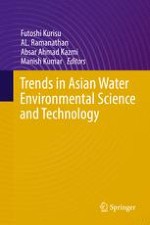2017 | OriginalPaper | Buchkapitel
Response Surface Optimization of Phosphate Removal from Aqueous Solution Using a Natural Adsorbent
verfasst von : Prangya Ranjan Rout, Puspendu Bhunia, Rajesh Roshan Dash
Erschienen in: Trends in Asian Water Environmental Science and Technology
Aktivieren Sie unsere intelligente Suche, um passende Fachinhalte oder Patente zu finden.
Wählen Sie Textabschnitte aus um mit Künstlicher Intelligenz passenden Patente zu finden. powered by
Markieren Sie Textabschnitte, um KI-gestützt weitere passende Inhalte zu finden. powered by
Phosphorous exists in the form of orthophosphate, polyphosphates, pyrophosphate, organic phosphate esters and organic phosphonates, and all these forms could be hydrolyzed to orthophosphate (Majed et al. 2012). Orthophosphate could be utilized by microorganisms, plants and animals for their growth and development. Hence, considered as a vital nutrient in most of the ecosystems and due to its low concentration occurrence in the environment, it usually serves as the limiting nutrient (Huang et al. 2013). Sustained inputs of phosphate (more than 1 mg L−1) to aquatic environments lead to increased rates of eutrophication affecting the quality of domestic, industrial, agricultural and recreational water resources. Then again, phosphorous is an important element, extensively contributing towards many biological, agricultural, industrial, environmental, medical and household applications. Therefore, the excess discharge of phosphates to aquatic environments is taking place through various anthropogenic activities such as the use of fertilizers, pigments, detergents and electronic industry discharge, domestic wastewater discharge, mineral processing, rural and urban sewage disposal etc. (Wang et al. 2013). Excepting eutrophication, the increasing loads of phosphates in water bodies stimulate the activity of a damaging microbe known as , speed up the production of microsystin, a toxin that poisons aquatic animals and can cause hepatocellular carcinoma in humans, and result in depletion of desirable flora and fauna (Yuan et al. 2006; Rout et al. 2015a). In order to prevent these problems phosphorous removal from wastewater is highly desirable before discharging. The World Health Organization (WHO) recommended a maximum discharge limit of phosphorous as 0.5–1.0 mg L−1 (Galalgorchev 1992). Therefore, in the current scenario, more and more stringent regulatory limits of phosphate discharge have been set by many nations and regions worldwide.
